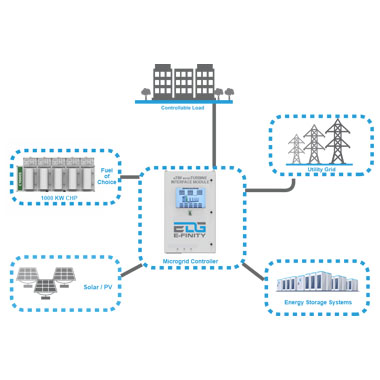In a digital-first economy, uptime isn’t a luxury–it’s an absolute requirement. Every minute of data center downtime costs an average of $9,000 or more, and those costs only rise with the growing reliance on AI, real-time data processing, and cloud-based services.
For Tier III and Tier IV data centers, even a momentary power interruption is unacceptable. These facilities are held to extremely high standards: just 1.6 hours of downtime per year for Tier III, and less than 26 minutes for Tier IV. That level of reliability demands more than traditional backup power–it requires a smarter, more resilient energy strategy.
Microgrids are quickly emerging as that solution. Designed to operate both in parallel with and independently from the grid, microgrids offer unmatched reliability, flexibility, and control. They’re redefining how data centers plan for and deliver uptime.
II. Understanding Microgrids
At their core, microgrids are self-contained energy systems that can generate, store, and distribute power locally. They include:
- Generation assets like gas turbines, combined heat and power (CHP) units, or solar
- Energy storage systems such as batteries or flywheels
- Control systems that monitor, manage, and switch power sources in real-time
Unlike grid-tied backup solutions, microgrids can continue operating during grid outages–ensuring uninterrupted power to critical infrastructure.
Microgrids can be fully custom-designed or modular. While bespoke systems may suit unique constraints, pre-engineered modular microgrids offer significantly faster deployment timelines, cost predictability, and the ability to scale in phases.
III. The Uptime Challenge for Data Centers
Data centers are built with redundancy in mind, but uptime expectations keep climbing. Tier III facilities must maintain 99.982% uptime, while Tier IV pushes that bar to 99.995%. The challenge is especially acute with AI workloads, which introduce higher power demands and longer task runtimes that are highly sensitive to disruption.
A power loss during AI training can corrupt model checkpoints, waste GPU compute hours, and lead to expensive rework. The fallout from a single outage includes more than just technical headaches:
- SLA violations and financial penalties
- Regulatory non-compliance
- Reputational damage and lost client trust
Traditional backup systems–primarily diesel generators–are increasingly seen as inadequate. They're slow to start, require frequent testing, depend on fuel logistics, and can’t match the speed or flexibility needed in modern environments.
IV. How Microgrids Improve Uptime
1. Island Mode Operation
Microgrids can detect grid instability in milliseconds and seamlessly transition to on-site generation–without waiting for diesel engines to spin up or for automatic transfer switches (ATS) to engage. This near-instant failover preserves compute and cooling integrity.
2. Redundant, Behind-the-Meter Power
Rather than relying on a single backup source, microgrids draw from multiple distributed energy resources (DERs). They also work in concert with UPS systems and batteries to maintain constant voltage during transitions.
One often-overlooked component is mechanical UPS equipment that stabilizes voltage during those critical seconds before traditional generators fully come online. With microgrids, that buffer is built into the system design–removing the weak link entirely.
3. Advanced Controls & Real-Time Monitoring
Modern microgrid controllers offer sub-second switching and predictive analytics:
- Detect frequency or voltage drops instantly
- Orchestrate generation, storage, and facility loads in real time
- Integrate with BMS, EMS, and DCIM platforms for full visibility and control
These controls don’t just respond–they anticipate faults, rebalance loads, and ensure no downtime even during complex transitions.
4. Load Prioritization and Stability
Microgrids can prioritize mission-critical systems–compute, networking, and cooling–using dynamic load shedding. This ensures that even during partial outages, the systems that matter most stay operational.
They also manage spinning reserves and balance high-volatility loads from dense compute clusters.
5. Fuel Flexibility and Long-Duration Resilience
Microgrids reduce dependency on diesel by using natural gas, renewable gas, or hydrogen-capable turbines. Unlike diesel generators that require fuel deliveries during extended outages, microgrids tied to utility gas lines or renewables support longer-duration resilience without logistical overhead.
V. Microgrids vs. Traditional Backup Systems
| Feature | Microgrid | Diesel Backup |
|---|---|---|
| Response Time | Instantaneous or sub-second | Delayed due to spin-up |
| Maintenance Needs | Lower (fewer moving parts, real-time diagnostics) | High (frequent testing, manual inspections) |
| Emissions | Clean, low-NOx (especially CHP) | High emissions, non-compliant in some zones |
| System Reliability | Distributed and modular | Centralized, single-point-of-failure risk |
Microgrids drastically outperform diesel in emission-sensitive environments. CHP-based systems, for example, meet the toughest air quality standards while delivering reliable base-load power.
VI. Hypothetical Scenario
A 10MW data center relies on a traditional diesel backup system. During a peak AI training cycle, the local grid experiences a brownout.
- Diesel Scenario: 7–10 seconds of power loss during generator spin-up. The result? Lost AI checkpoint, failed job, thousands in wasted compute, potential SLA breach.
- Microgrid Scenario: The system auto-detects the disturbance, shifts to island mode in milliseconds, prioritizes the cooling loop and GPU clusters, and maintains perfect uptime.
VII. Financial and Operational Impacts
Microgrids help avoid:
- SLA breaches, which can cost thousands per incident
- Unpredictable energy costs, thanks to power purchase agreements or gas hedging
- Lost revenue during interconnection delays (microgrids can bring sites online before utility upgrades are complete)
They also open new value streams: demand response, capacity market participation, and even frequency regulation.
VIII. Planning Considerations
Deploying a microgrid requires careful planning:
- Understand your existing power architecture–not all sites are microgrid-ready without retrofits.
- Coordinate early with utility providers to streamline interconnection agreements.
- Design for N+1 or 2N redundancy, ensuring resilience meets Tier certification requirements.
Microgrid sizing should follow a top-down approach:
“We start with the peak power requirements,” explains one engineer. “Then we identify the right base generator node for the project. We assess efficiency, lead times, and pricing. From there, we model uptime with predictive analytics and build in the redundancy required to meet certification standards.”
IX. The Future of Uptime-Driven Microgrids
The next generation of microgrids will be AI-optimized, with:
- Forecast-based dispatching
- Predictive maintenance scheduling
- Fully autonomous operations integrated into the data center’s BMS and DCIM stack
Expect to see widespread adoption in edge and hyperscale deployments where utility capacity is constrained, and timelines are compressed.
Microgrids will not only protect uptime–they’ll become strategic enablers of faster go-live, cleaner energy, and higher ROI.


